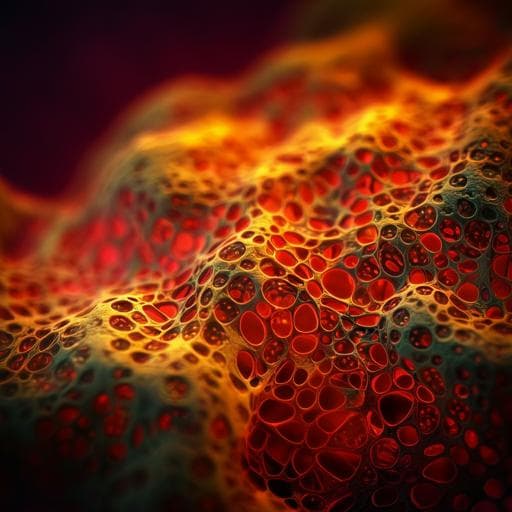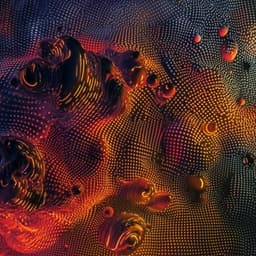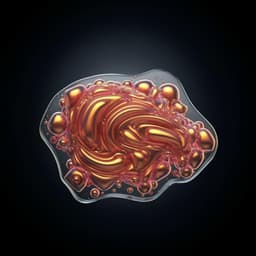
Medicine and Health
Optimized single-step optical clearing solution for 3D volume imaging of biological structures
K. Kim, M. Na, et al.
Discover OptiMuS, a groundbreaking single-step optical clearing solution developed by Kitae Kim and colleagues that rapidly enhances tissue transparency while maintaining size and fluorescent signals. Perfect for 3D imaging of vascular structures and detailed morphological analysis, this innovation revolutionizes biological imaging.
~3 min • Beginner • English
Introduction
Deep 3D imaging in intact biological tissues is hindered by optical heterogeneity and light scattering, traditionally prompting laborious sectioning that risks deformation. Numerous optical clearing techniques—organic solvent-based or aqueous-based—have been developed, but each faces trade-offs such as tissue shrinkage/expansion, long incubation, complexity, limited fluorescence preservation, or incompatibility with lipophilic dyes. The unmet need is a simple, rapid, single-solution clearing approach that simultaneously maximizes transparency, preserves tissue size and endogenous fluorescence, and is dye-compatible. This study addresses that gap by formulating OptiMuS—combining iohexol, urea, and D-sorbitol—hypothesized to synergize refractive index matching (iohexol), hyperhydration-driven penetration (urea), and gentle clearing with size preservation (sorbitol) to achieve superior transparency in thick tissues without deformation while maintaining fluorescence and dye compatibility.
Literature Review
Organic solvent-based methods (e.g., Benzoic Acid Benzyl Benzoate, dibenzyl ether, 3DISCO, uDISCO) rapidly achieve high transparency via high-refractive-index solvents but typically cause substantial shrinkage and quench protein fluorescence. Aqueous methods preserve fluorescence and size better and include: simple immersion in high-RI media (2,2'-thiodiethanol; fructose-based SeeDB), which are effective for thin samples but limited in thick tissue due to viscosity and penetration; low-viscosity index-matching alternatives (diatrizoic acid/FocusClear, iohexol/RIMS) that improve penetration but still suffer from slow/insufficient clearing; hyperhydration with urea plus detergents (Scale, ScaleS, CUBIC; FRUIT) that enhance clearing yet can be slow, lose proteins, or be complex; hydrogel-embedding with active/passive lipid removal (CLARITY and variants) that can clear effectively but need specialized equipment and are incompatible with lipophilic dyes; and the MXDA-based MACS, a DiI-compatible system requiring sequential solutions and showing moderate visible-range transparency. Prior approaches thus lack a single-step method that balances transparency, speed, size retention, simplicity, and dye compatibility.
Methodology
Reagent design and optimization: The authors combined iohexol (high RI ~1.46, low viscosity) with urea (hyperhydration to reduce scattering and improve penetration) and D-sorbitol (gentle clearing and size preservation). They first optimized urea and sorbitol, finding 4 M urea with 10% D-sorbitol achieved ~58% transparency while maintaining size. Adding 75% (w/v) iohexol elevated transparency to ~75% without size change. The final OptiMuS solution (RI ~1.47) was prepared by dissolving 75% histodenz (iohexol) in Tris-EDTA (100 mM Tris, 0.34 mM EDTA, pH 7.5) at 60°C, then adding 10% D-sorbitol and 4 M urea at 60°C; cooled to room temperature and used at 37°C.
Comparative clearing performance: 1-mm rat brain slices and other tissues were cleared with OptiMuS versus CLARITY, CUBIC, ScaleS, ScaleSQ(0), SeeDB2G, FOCM, and MACS. Clearing timelines, size changes (bright-field imaging with ImageJ-based outline analysis; linear expansion from area change), and transparency (spectrophotometer 400–800 nm; or grid-based relative transmittance) were quantified. Structural integrity was assessed by confocal imaging of Thy1-EYFP dendrites for tortuosity and soma SSIM pre/post clearing.
Fluorescence preservation and imaging depth: EYFP signals in 50-µm Thy1-EYFP brain slices were imaged daily up to 4 days after clearing to compute normalized fluorescence retention. For imaging depth/quality, 1-mm Thy1-EYFP brain slices were imaged by confocal microscopy at 5-µm steps, and SNR versus depth was calculated by comparing dendrite signal to adjacent background.
Whole-organ and multi-label imaging: Whole mouse brains from Thy1-EYFP mice were cleared (3 days) and imaged with LSFM to visualize cell bodies and neurites. ChAT-Cre-tdTomato mouse intestine and brain were cleared and imaged to visualize cholinergic plexuses and NAc neurons. OptiMuS was also used as an RI-matching medium for samples pre-cleared/stained via CLARITY (lectin, anti-GFAP, anti-Tuj-1), enabling high-resolution 3D imaging.
DiI compatibility: Mice received transcardial perfusion with DiI to label vasculature in brain, kidney, spleen, and intestine; organs were fixed and cleared with OptiMuS. LSFM and confocal imaging assessed preservation of DiI signal and 3D vascular architecture, including thick (up to 2800 µm) samples.
Kidney disease analysis: In an NTN model (anti-GBM induced) and normal controls, DiI-labeled kidneys were imaged (z-stacks at 4 µm) by LSFM. DXplorer software performed semi-automated 3D mesh reconstruction and feature extraction of glomeruli (volume, maximum head diameter hMax, maximum neck diameter nMax). Validation was done by manual Meshlab measurements. Statistical analyses used Shapiro-Wilk for normality, t-tests or one-way ANOVA with Tukey’s test as appropriate.
Animal and ethics: Standard fixation (PBS then 4% PFA perfusion), sectioning via vibratome, and imaging on confocal and LSFM platforms; IACUC approvals were obtained.
Key Findings
- Composition and optics: OptiMuS (75% iohexol + 4 M urea + 10% D-sorbitol in Tris-EDTA, RI ~1.47) achieved ~75% transparency in optimization while preserving size.
- Rapid, size-preserving clearing: 1-mm rat brain tissues became highly transparent within 1.5 hours with negligible size change (0.93 ± 1.1% shrinkage). Across methods, OptiMuS provided superior overall performance in transparency, clearing speed, and size retention compared to CLARITY, CUBIC, ScaleS, ScaleSQ(0), SeeDB2G, FOCM, and MACS.
- Spectral transparency: Higher transmittance than comparators across 400–800 nm in 1-mm rat brain slices; quantitative assessments positioned OptiMuS as best for transparency vs. size change.
- Structural preservation: No detectable deformation of dendritic ultrastructure or soma morphology post-clearing (tortuosity and SSIM analyses unchanged).
- Fluorescence retention: >90% EYFP fluorescence preserved after 4 days with OptiMuS; significantly better than CLARITY and FOCM and comparable to others in this assay. FOCM lost most fluorescence after 1 day in the authors’ hands.
- Imaging depth and SNR: In 1-mm Thy1-EYFP brain slices, SNR started at 4.31 and did not decline up to 1 mm depth post-OptiMuS, whereas PBS controls lost visible signal beyond ~280 µm.
- Whole-organ 3D imaging: Whole mouse brains cleared in 3 days revealed fine neural structures (cortex, striatum) with single-cell resolution. ChAT-Cre-tdTomato intestine showed clear myenteric and submucosal plexuses; NAc neurons imaged in 3D.
- RI matching for immunostained samples: OptiMuS enabled high-resolution 3D imaging of CLARITY-cleared and immunostained brain and intestine (e.g., GFAP, lectin, Tuj-1).
- DiI compatibility: OptiMuS preserved DiI-labeled vasculature in whole brain, kidney, spleen, and intestine. Thick (up to 2800 µm) brain samples showed fine vascular arborization throughout depth; LSFM 3D reconstructions and depth-coded maps demonstrated intact, traceable vascular networks.
- Kidney disease quantification: In NTN kidneys, glomeruli exhibited significantly increased volume, hMax, and nMax versus normal (n=18 normal, n=10 NTN; p<0.001), validated against manual Meshlab measurements, demonstrating feasibility of automated comparative 3D morphometry with DXplorer.
Discussion
The study set out to create a single-step aqueous clearing solution that balances transparency, speed, structural integrity, fluorescence preservation, and dye compatibility. By combining iohexol, urea, and sorbitol, OptiMuS achieved rapid, high transparency with minimal size distortion, outperforming prevalent aqueous methods across spectral transmittance and deformation metrics. It maintained endogenous fluorescence over days and sustained high SNR through millimeter-scale depths, enabling comprehensive 3D visualization of neural and vascular architectures. Crucially, its non-delipidating, RI-matching nature preserves lipophilic dye signals (e.g., DiI), enabling whole-organ vascular mapping and quantitative 3D analysis. Compared to methods like ScaleSQ(0), FOCM, and MACS, OptiMuS avoided severe size changes or multi-step complexity and produced more consistent fluorescent signal preservation in the authors’ testing. Applications to disease modeling (NTN kidneys) showcased robust, automated morphometric analysis via DXplorer, suggesting broader utility for objective 3D phenotyping. The authors discuss method-specific discrepancies (e.g., FOCM) and emphasize potential integration with label-free OCT to extend imaging depth while maintaining structural fidelity, highlighting a pathway to rapid, digital 3D histopathology.
Conclusion
OptiMuS is a simple, rapid, single-solution optical clearing method that delivers high transparency, excellent size preservation, and robust endogenous fluorescence retention across diverse tissues. It supports single-cell resolution 3D imaging and is compatible with lipophilic dyes, enabling comprehensive vascular mapping and quantitative morphometric analyses, as demonstrated in healthy and NTN kidneys with DXplorer. Given its performance and versatility, OptiMuS can serve as a first-line clearing approach for 3D volume imaging and potentially integrate with label-free modalities like OCT for fast 3D histopathology. Future work includes organ-specific optimization of composition/timelines, broader validation across tissues and disease models, and further development of automated, ML-driven feature classification in DXplorer for objective diagnostics.
Limitations
- Slightly slower clearing than some methods (ScaleSQ(0), FOCM, MACS) though with markedly better size preservation.
- Somewhat greater deformation observed in non-brain organs, indicating a need for organ-specific optimization of composition and timelines.
- Reported discrepancies with FOCM (shrinkage, fluorescence loss) relative to prior publications; potential confounds include species/age/region differences.
- DXplorer-based glomerular analysis required interactive proofreading due to imaging artifacts and edge effects; automated pipelines may need further refinement.
- For OCT integration, excessive clearing may reduce reflectivity; careful optimization is required to balance clearing depth and signal.
Related Publications
Explore these studies to deepen your understanding of the subject.







